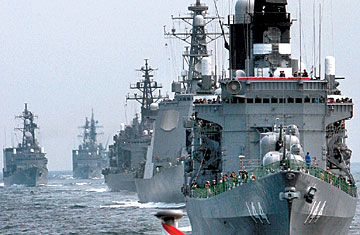
Show of Force: Japanese ships line up during exercises off Sagami Bay last October. At $42 billion, the nation?s annual military budget is the world's sixth largest
If I'd been flying a real helicopter, I'd be dead and the government of Japan would be out $50 million, the cost of one these flying monsters (it has 10). They wouldn't miss me — and they might not miss the $50 million either. Though its constitution officially prohibits war and its army and navy are innocuously called "self-defense forces (SDF)," Japan is a stealth military power, with an annual budget of around $42 billion — the sixth largest in the world. Despite all that money, Japan's armed forces have traditionally kept a very low profile, at home and abroad. But that's begun changing. Over the past few years, Japanese forces have taken part in operations in Iraq and the Indian Ocean. Conservative Prime Minister Shinzo Abe last month elevated Japan's Defense Agency to a full-fledged Cabinet-level ministry, and is aiming to change the country's pacifist constitution, which could open the door for more frequent foreign deployments for the SDF. "For the past 50 years, Japan intentionally ignored the matter of defense," says Toshiyuki Shikata, a defense analyst at Teikyo University. But now, he adds, Japan is waking up to its own military power.
That change is slowly playing out at Iwakuni. The seaside MSDF facility not far from Hiroshima was a main Japanese air force base through World War II, before it was eventually taken over by the Americans, and the grounds are now shared with the U.S. Marines. It's in the midst of a $1.9 billion expansion program, paid for by the Japanese government, and its contingent of U.S. planes will eventually double to over 100 as part of an American force realignment. There's a reason for the move — Iwakuni is within striking distance of every potential hot spot in Northeast Asia, from Beijing to Pyongyang to Taipei. As he gives a group of foreign journalists a briefing on Iwakuni, Satoru Shoji, an MSDF captain with the blunt build and cauliflower ears of a rugby player, points toward the area west of Japan on a map and says, "This is the area we have to watch out for." There isn't any doubt which countries he's referring to: North Korea and China.
The specter of a rearming and aggressive Japan gives the rest of Asia flashbacks to WWII, but the truth is that Iwakuni, like all Japanese military facilities, is far more defensive than offensive. While missile-armed FA-18 Hornets launch daily from the American side of the base, Japan's hangars are filled with craft like the MH-53, which sweep for mines, and the US-1A, a giant propeller-powered flying boat that has participated in hundreds of sea rescues.
Flying the slow, obese US-1As seems like junior-varsity stuff compared to the Top Gun U.S. marine aviators at Iwakuni — until I'm put in another flight simulator. Fortunately this time a professional is at the controls, Lt. JG Yoichiro Sagawa, who takes me through the procedure of landing a whale-sized seaplane on 10-ft.-high waves. Seaplanes manage to combine the worst aspects of airsickness and seasickness, and I fear that a simulated flight might make me lose my actual lunch. But Lt. Sagawa has a much surer hand that I do. "Once you get in that seat, you know right away who can do it and who can't," he says, with the confidence of years of training. It's not just superior technology that makes Japan's military better in many ways to its Asian neighbors, but superior human capital — not unlike the formula Japan used to become the world's second-largest economy.
For now, all that skill is still in the service of a military that is, as the name says, a self-defense force — with most of the actual force provided by Japan's omnipresent American allies, treaty-bound to defend Japan. (The division of labor is obvious at Iwakuni — the U.S. keeps nearly half of the base to itself, shares most of the rest with Japan, which solely operates only 0.5% of the property.) Still, as the country's politics change to allow a more assertive foreign policy, Japan may not remain a stealth military power for long.
With reporting by Michiko Toyama/Tokyo
